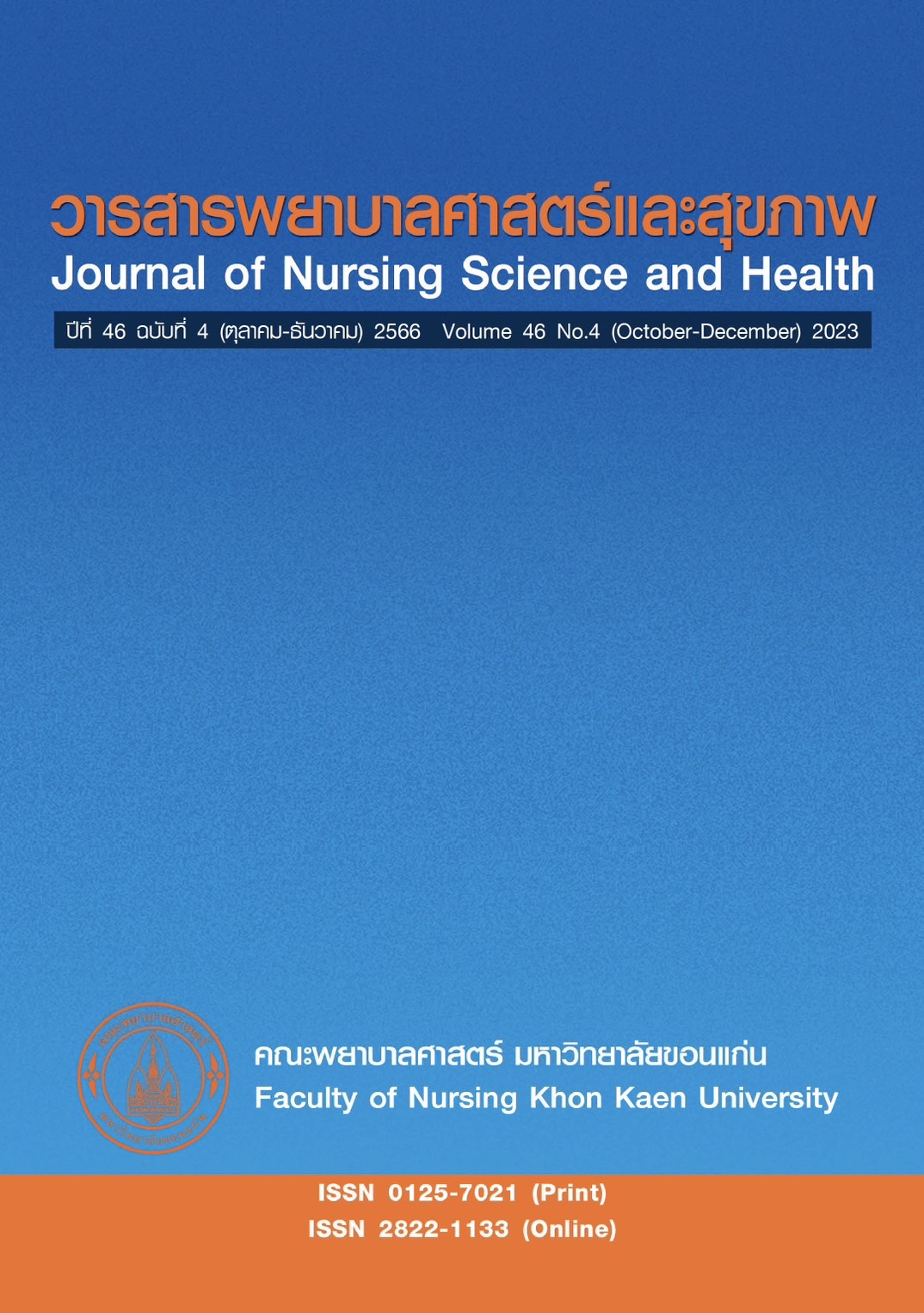ผลของแนวปฏิบัติการพยาบาลเพื่อป้องกันภาวะน้ำเกินในผู้ป่วยที่มีภาวะติดเชื้อในกระแสเลือด และภาวะช็อกจากการติดเชื้อในกระแสเลือด: การศึกษาความเป็นไปได้
คำสำคัญ:
การป้องกันภาวะน้ำเกิน, แนวปฏิบัติการพยาบาล, ภาวะช็อกจากการติดเชื้อในกระแสเลือด, ภาวะติดเชื้อในกระแสเลือดบทคัดย่อ
การให้สารน้ำในการช่วยชีวิตในระยะแรกเป็นมาตรฐานในการดูแลรักษาผู้ป่วยที่มีภาวะติดเชื้อในกระแสเลือดและภาวะช็อกจากการติดเชื้อในกระแสเลือด แต่อย่างไรก็ตามผู้ป่วยที่ได้รับสารน้ำมากเกินไปมีความเสี่ยงสูงที่จะเกิดภาวะน้ำเกิน การศึกษานี้มีวัตถุประสงค์เพื่อพัฒนาและศึกษาความเป็นไปได้ของแนวปฏิบัติการพยาบาลเพื่อป้องกันภาวะน้ำเกินในผู้ป่วยที่มีภาวะติดเชื้อในกระแสเลือดและภาวะช็อกจากการติดเชื้อในกระแสเลือด ซึ่งพัฒนาขึ้นโดยใช้รูปแบบการพยาบาลตามหลักฐานเชิงประจักษ์ของ “ชูคัพ” เป็นกรอบแนวคิดในการพัฒนา และนำไปใช้ในการดูแลผู้ป่วยที่มีภาวะติดเชื้อในกระแสเลือดและภาวะช็อกจากการติดเชื้อในกระแสเลือด จำนวน 10 ราย ผลลัพธ์ของการศึกษา คือ ภาวะน้ำเกินซึ่ง หมายถึง การที่มีน้ำหนักตัวเพิ่มขึ้นมากกว่าร้อยละ 10 ของน้ำหนักตัว
ผลการศึกษาแสดงให้เห็นว่า หลังได้รับการดูแลตามแนวปฏิบัติการพยาบาลเพื่อป้องกันภาวะน้ำเกินในผู้ป่วยที่มีภาวะติดเชื้อในกระแสเลือดและภาวะช็อกจากการติดเชื้อในกระแสเลือด ผู้ป่วยมีน้ำหนักตัวเพิ่มขึ้นเฉลี่ยเท่ากับ 4.64 (SD=2.65) และไม่มีผู้ป่วยที่มีน้ำหนักเพิ่มขึ้นเกินร้อยละ 10 หรืออาจกล่าวได้ว่าผู้ป่วยทั้งหมดไม่เกิดภาวะน้ำเกิน
การศึกษานี้ชี้ให้เห็นว่าแนวปฏิบัติการพยาบาลที่พัฒนาขึ้นมีประโยชน์ในการป้องกันการเกิดภาวะน้ำเกินในผู้ป่วยที่มีภาวะติดเชื้อในกระแสเลือดและภาวะช็อกจากการติดเชื้อในกระแสเลือด
เอกสารอ้างอิง
Evans L, Rhodes A, Alhazzani W, Antonelli M, Coopersmith CM, French C, et al. Surviving sepsis campaign: International guidelines for management of sepsis and septic shock. Intensive Care Medicine 2021;47(11):1181–247.
Singer M, Deutschman CS, Seymour C, Shankar-Hari M, Annane D, Bauer M, et al. The third international consensus definitions for sepsis and septic shock (sepsis-3). Journal of the American Medical Association 2016;315(8):801-10.
Rudd KE, Johnson SC, Agesa KM, Shackelford KA, Tsoi D, Kievlan DR, et al. Global, regional, and national sepsis incidence and mortality, 1990–2017: Analysis for the global burden of disease study. The Lancet 2020;395(10219):200-11.
Ministry of Public Health. Mortality rate in community acquired sepsis. Health Data Center: HDC. [Internet]. 2022 [cited 2023 Jun 20]. Available from: https://hdcservice.moph. go.th (in Thai)
Medical records. Inpatient statistics patients with sepsis and septic shock. Khon Kaen: Srinagarind Hospital; 2021. (in Thai)
Dugar S, Choudhary C, Duggal A. Sepsis and septic shock: Guideline-based management. Cleveland Clinic Journal of Medicine 2020;87(1):53–64.
Sakr Y, Rubatto Birri PN, Kotfis K, Nanchal R, Shah B, Kluge S, et al. Higher fluid balance increases the risk of death from sepsis: Results from a large international audit. Criti Care Med 2017;45(3):386–94.
Khan RA, Khan NA, Bauer SR, Li M, Duggal A, Wang X, et al. Association between volume of fluid resuscitation and intubation in high-risk patients with sepsis, heart failure, end-stage renal disease, and cirrhosis. Chest 2020;157(2):286–92.
Marik PE. Iatrogenic salt water drowning and the hazards of a high central venous pressure. Annals of intensive care 2014;4(1):1-9. doi. org/10.1186/s13613-014-0021-0.
Malbrain ML, Marik PE, Witters I, Cordemans C, Kirkpatrick AW, Roberts DJ, et al. Fluid overload, de-resuscitation, and outcomes in critically ill or injured patients: A systematic review with suggestions for clinical practice. Anaesthesiology intensive therapy 2014; 46(5):361-80.
Granado CD, Mehta RL. Fluid overload in the ICU: Evaluation and management. BMC Nephrology 2016;17(1):1–9.
Mitchell KH, Carlbom D, Caldwell E, Leary PJ, Himmelfarb J, Hough CL. Volume overload: Prevalence, risk factors, and functional outcome in survivors of septic shock. Annals of the American Thoracic Society 2015;12(12):1837–44.
Akbar R, George Y, Madjid AS, Sedono R, Tantri A. Early administration of norepinephrine prevents the occurrence of fluid overload in the resuscitation of septic shock patients. Critical Care and Shock 2021;24(5):257-68.
Soukup SM. The center for advanced nursing practice evidence-based practice model: Promoting the scholarship of practice. Nurs Clin North Am 2000;35(2):301-9.
The Joanna Briggs Institute. Reviewers’ manual 2014 edition. Australia: Solito Fine Colour Printers [Internet]. 2014 [cited 2023 Jun 20]. Available from:http://www.joannabriggs.org/ asscts/docs/ sumari/reviewersmanual-2014. pdf.
Akhter M, Potter T, Stowell J. The safety of the sepsis fluid bolus for patients at increased risk of volume overload. American Journal of Emergency Medicine 2021;41:6-8.
Leisman D, Wie B, Doerfler M, Bianculli A, Ward MF, Akerman M, et al. Association of fluid resuscitation initiation within 30 minutes of severe sepsis and septic shock recognition with reduced mortality and length of stay. Ann Emerg Med 2016;68(3):298-311.
Rhodes A, Evans LE, Alhazzani W, Levy MM, Antonelli M, Ferrer R, et al. Surviving sepsis campaign: International guidelines for management of sepsis and septic shock 2016. Intensive Care Medicine 2017;43(3): 304-77.
Marik PE, Linde-Zwirble WT, Bittner EA, Sahatjian J, Hansell D. Fluid administration in severe sepsis and septic shock, patterns and outcomes: An analysis of a large national database. Intensive care medicine 2017;43(5):625-32.
Lat I, Coopersmith CM, De Backer D, Coopersmith CM. The surviving sepsis campaign: Fluid resuscitation and vasopressor therapy research priorities in adult patients. Intensive Care Med Exp 2021;9(1):623-35.
Thompson K, Venkatesh B, Finfer S. Sepsis and septic shock: Current approaches to management. Intern Med J 2019;49(2): 160-70.
Koratala A, Ronco C, Kazory A. Diagnosis of fluid overload : From conventional to contemporary concepts. Cardiorenal Med 2022;12(4):141-54.
Elhassan MG, Chao PW, Curiel A. The conundrum of volume status assessment: Revisiting current and future tools available for physicians at the bedside. Cureus 2021; 13(5):e15253. doi: 10.7759/cureus.15253
Pimpun P, Theeranut A, So-ngern A. Development of nursing practice guidelines for promoting patients with successful noninvasive ventilation: A pilot study. Journal of Nursing Science & Health 2020;43(1):109-17. (in Thai)
Rawangdee A. Methakanjanasak N. Effects of fluid management clinical nursing practice guideline (CNPG) on selected outcomes in patients with sepsis at emergency department, Chum Phae hospital. Journal of Nursing and Health Care 2020;38(1):32-41. (in Thai)
Messmer AS, Zingg C, Müller M, Gerber JL, Schefold JC, Pfortmueller CA. Fluid overload and mortality in adult critical care patients a systematic review and meta-analysis of observational studies. Criti C Med 2020; 48(12): 1862–70. doi.org/10.1097/ CCM.0000000000004617
Ravi C, Johnson DW. Optimizing fluid resuscitation and preventing fluid overload in patients with septic shock. Semin Respir Crit Care Med 2021;42(05):698-705. doi: 10.1055/s-0041-1733898
Acheampong A, Vincent JL. A positive fluid balance is an independent prognostic factor in patients with sepsis. Critical care (London, England) 2015;19(1):251. doi. org/10.1186/s13054-015-0970-1
Hjortrup PB, Haase N, Bundgaard H, Thomsen SL, Winding R, Pettila V, et al. Restricting volumes of resuscitation fluid in adults with septic shock after initial management: The CLASSIC randomized, parallel-group, multicenter feasibility trial. Intensive Care Med 2016;42(11):1695-705.
ดาวน์โหลด
เผยแพร่แล้ว
รูปแบบการอ้างอิง
ฉบับ
ประเภทบทความ
สัญญาอนุญาต
ลิขสิทธิ์ (c) 2023 วารสารพยาบาลศาสตร์และสุขภาพ

อนุญาตภายใต้เงื่อนไข Creative Commons Attribution-NonCommercial-NoDerivatives 4.0 International License.
วารสารพยาบาลศาสตร์และสุขภาพเป็นเจ้าของลิขสิทธิ์ในการเผยแพร่ผลงานที่ตีพิมพ์ห้ามผู้ใดนำบทความที่ได้รับการตีพิมพ์ในวารสารพยาบาลศาสตร์และสุขภาพไปเผยแพร่ในลักษณะต่าง ๆ ดังนี้ การนำบทความไปเผยแพร่ออนไลน์ การถ่ายเอกสารบทความเพื่อกิจกรรมที่ไม่ใช่การเรียนการสอน การส่งบทความไปตีพิมพ์เผยแพร่ที่อื่น ยกเว้นเสียแต่ได้รับอนุญาตจากวารสารพยาบาลศาสตร์และสุขภาพ



